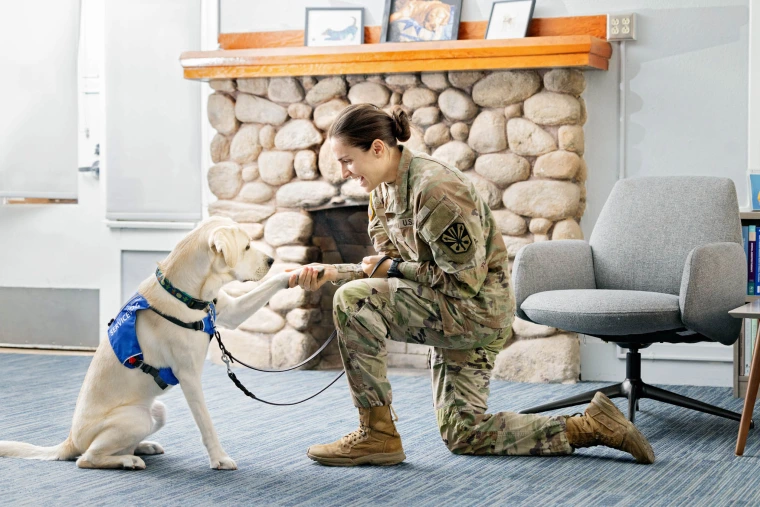Creature Comfort
How U of A researchers are using service dogs to alleviate PTSD

Chris Richards photos
Every veteran struggling with PTSD knows these moments: Some noise sets you off. A bit of panic sets in.
If you are accompanied by a service dog trained in how to react, you give the command, “Look.” Your service dog steps up to watch your back, sending a message: “You are safe.” Suddenly, you feel safer.

Lead research technician and service member 2nd Lt. Elizabeth Bandin with Yaeger and primary investigator Maggie O’Haire.
Chris Richards photos
Over time, the bond between human and canine can be life-changing, says Carly Kramer at K9s For Warriors, a partner with the University of Arizona in research on canine-human interactions.
The cost to obtain a trained service dog can exceed $15,000, most of which is paid by nonprofits like K9s. The U of A’s scientific study may help generate more funding to help veterans with PTSD, or post-traumatic stress disorder, get service dogs, and that could help reduce the high volume of stress-related suicide among U.S. veterans.
A dog gets six to eight months of intensive training to help their veteran counter depression or anxiety. Maggie O’Haire, a professor and the associate dean for research at the College of Veterinary Medicine, leads nationwide research funded by $8.4 million from the U.S. Department of Defense and $3.8 million from the National Institutes of Health to analyze the stories told by hundreds of veterans.
Some accounts are profound. Often, someone will tell her, “I would not be alive if it were not for my service dog.”
And yet, O’Haire says, many veterans face barriers because there isn’t yet enough scientific evidence to support big investments in service dogs.
The U.S. Department of Veterans Affairs reports that approximately 20% of post-9/11 veterans suffer from PTSD. Yet the current wait time to be partnered with a trained service dog can exceed two years.
“It’s their statements and stories that motivate me when I show up to work each day to help support them,” O’Haire says.
Her staff of 15, plus a corps of student workers, spend their days talking with some 150 veterans with service dogs throughout the country. These team members help the veterans send in a trove of daily data on their health and behavior.
Some staff are veterans themselves, and several have family members who have seen combat. Others engage in academic work in veterinary medicine or psychology.
The U of A researchers compare two groups: veterans living with a service dog and a group still on the waiting list. The variables for this research include rates of PTSD symptoms, levels of stress-related hormones, sleep quality and body chemistry issues reflected in saliva tests.
The team also uses the gold-standard measures for conditions like depression and anxiety, and works with outside experts who conduct telehealth PTSD measures.

Undergraduate research assistant Joshua Baus with mentor and Ph.D. candidate Sarah Leighton.
Mindy Burnett
“The veterans learn how to do all the assessments and how to call a clinician and use their sleep wristbands. They learn how to collect, freeze and send back saliva for testing,” O’Haire says. “We build relationships with the veterans and help them share their stories.”
To enhance service-dog screening, the university’s Arizona Canine Cognition Center focuses on identifying the ideal traits that will help a veteran achieve their goals. “Not every dog is made for — or wants — the same job,” O’Haire says. “This is a really specialized role that requires dogs that are suited for it.”
So far, the evidence is clear: A partnership with a service dog significantly predicts improvements in the everyday well-being of veterans. Particularly striking is the finding that a partnership with a service dog can help improve a veteran’s level of an essential hormone called cortisol, which plays vital roles at just the right levels — too much or too little can be harmful. PTSD can alter a veteran’s cortisol levels and present serious health risks, but the
U of A research shows that a veteran with a service dog will return to the cortisol levels of a healthy adult.
“The goal of a service dog is to be a complementary intervention, not something that stands alone,” O’Haire says. “Instead, these partnerships can enhance existing evidence-based care, medication or perhaps psychiatric treatment. And it works.”
For now, the need is urgent.
“Veterans deserve every resource that could help them,” O’Haire says.
